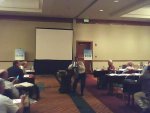Public Input No. 4314-NFPA 70-2014 [ Section No. 250.104(A)(1) ]
(1) General.
Metal water piping system(s) installed in or attached to a building or structure shall be bonded to the service
equipment enclosure, the grounded conductor at the service, the grounding electrode conductor where of
sufficient size, or to the one or more grounding electrodes used. The bonding jumper(s) shall be sized in
accordance with Table 250.66 except as permitted in 250.104(A)(2) and (A)(3). Bonding jumpers shall
not be required between the hot and cold water piping systems at hot water heaters to maintain the
continuity of the piping system.
Statement of Problem and Substantiation for Public Input
Substantiation: There seems to be some confusion as to when applying 250.104(A)(1) that a hot water heater
requires that the continuity between the hot and cold piping be maintained by the use of a bonding jumper, similar
to the ones required by 250.68(B) around water meters, etc. Sections 250.104(A)(1) and 250.68(B) are different in
that bonding jumpers required by 250.68(B) are to maintain the continuity of grounding electrode, the same
continuity requirement does not apply to the bonding of piping systems. This additional wording will clarify that
bonding jumpers are not required around hot water heaters to comply with 250.104(A)(1).
Submitter Information Verification
Submitter Full Name:robert meier
Organization: NA
Street Address:
City:
State:
Zip:
Submittal Date: Thu Nov 06 19:02:22 EST 2014
Committee Statement
Resolution: Plumbing fittings and fixtures may not always provide reliable bonding between hot and cold water
lines.
National Fire Protection Association Report


